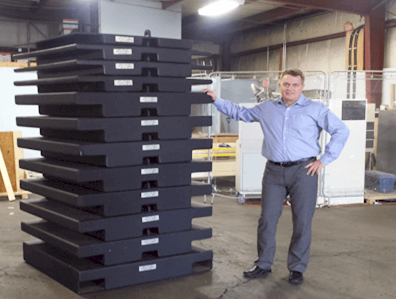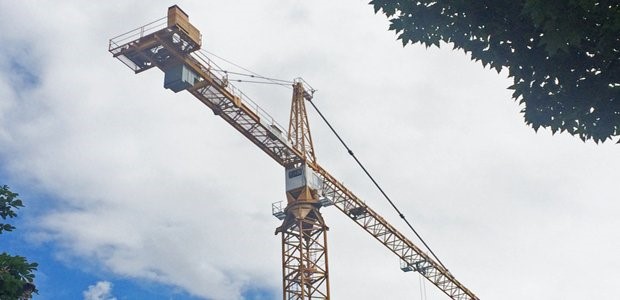According to OSHA or CCOHS requirements, all cranes & lifting devices in service must be tested yearly as frequent use wears safety-critical crane components.
Worn or damaged parts may result in the crane becoming inoperable or even failing dangerously, putting personnel at risk. By conducting frequent crane inspections, you can discover potential issues and deal with them before they arise.
To protect both workers and the facility, lifting equipment must be in good working order before being placed into operation. Any aspect of equipment inspection cannot be ignored when it comes to safety. The checking of equipment before it is used in operations is part of the equipment inspection and maintenance process.
Crane load testing is a critical tool for ensuring the safety of overhead hoists and cranes. It is described as “the process of applying a demand to a software system or computing device and measuring its response.” It’s commonly used to figure out how a device can behave under normal and peak load conditions.
Introduction to Crane Hoist Testing
Stackable Steel Crane Test Weights
 The traditional crane test weights are stackable steel or cast-iron weights. These test weights are suitable for proof load testing cranes, winches, and beams in low headroom and confined space applications, where the use of water-filled test weights would not be possible.
The traditional crane test weights are stackable steel or cast-iron weights. These test weights are suitable for proof load testing cranes, winches, and beams in low headroom and confined space applications, where the use of water-filled test weights would not be possible.
The common individual steel test weights range in size from 100 lbs. to 100,000 lbs or bigger, with the larger weights configured to enable stacking on lift stands.
Advantages of Steel Test Weights:
- Low working height, suitable for limited headroom applications.
- Time-saving for testing multiple cranes, as test loads can remain intact.
- Compact and portable, easily handled by forklift or crane hook.
- Suitable for standard rigging hardware.
- Smaller weights are available for hand-carrying.
- Steel weights provide precise testing results due to their consistent weight and minimal deflection.
- Durable and long-lasting, steel resists corrosion and wear better than other materials.
- Safety features like handles and lifting eyes make them easy to maneuver.
- Cost-effective, given their reusability and longevity.
- Easy to clean and maintain.
Steel crane hoist test weights offer numerous advantages over alternatives like cast iron, waterbags, and concrete weights. They are highly durable, withstanding harsh conditions and resisting corrosion, which ensures a longer lifespan. These weights are designed with safety in mind, featuring handles and lifting eyes for easy maneuverability, and are non-toxic and non-sparking, reducing injury and fire risks. Additionally, they are cost-effective due to their reusability, unlike other materials that may require frequent replacement. Steel weights are also easy to clean and maintain, needing only a cloth and some lubricant. However, they do have drawbacks, such as high transportation costs and storage challenges due to their heavyweight. Despite these disadvantages, steel test weights are a reliable and efficient choice for crane and hoist testing.
Water-Filled Weight Bag Load Test Weights
Water-filled weight bags offer a simple and safe alternative for crane test weights. They are particularly useful for proof load testing of lifting equipment and structures. These bags are advantageous for their minimal freight costs, reduced storage space requirements, and ease of handling.
These weights are suitable for:
- Cranes
- Beams
- Derricks
- Overhead cranes
- Such as crane load testing, beam load test, derrick load testing, overhead crane load test.
The water-weight bags have load cells weighing approximately 2% of their rated load weight. This feature keeps freight costs, storage space, floor loading and manpower to a minimum.
The use of water bags for our crane and hoist load testing services is recognised as a safe technique for slowly applying the test load. This means that potential problems can be identified long before the maximum load is reached. In addition, load water can be drained without having to lower the test weight. This would be helpful in situations where the hoisting system or brakes were compromised in some way.
The disadvantage is getting large amounts of water for bags and its cost for the water and then having to find a place to discharge this water.
Concrete Load Test Weights
Concrete weights are an alternative to steel and are also stackable but are less commonly used due to their lower density and larger volume, which makes them difficult to operate. They share some disadvantages with steel, such as susceptibility to damage and increased weight when wet. However, they are significantly cheaper than steel or cast iron.
The Basics of Load Test Requirements
A load test is performed to verify that a specific crane or hoist will safely perform all of its functions while supporting a test load whose weight is at least equal to the equipment’s rated capacity. Since load tests confirm the ability of the crane and hoist to safely operate as intended, they must be completed whenever this overhead lifting equipment is newly installed, altered, repaired, or modified before being placed into service. Existing crane and hoist systems should likewise be load tested at a minimum of once every four years.
The test load used must be at least 100% and no more than 125% of the equipment’s rated capacity unless otherwise recommended by the original equipment manufacturer (OEM). The weight itself should be certified prior to testing. Load tests should be dynamic, that is, they confirm that the overhead crane and hoist function safely and properly as they move to lift and lower the test load, as well as transport it over the length of the bridge and of the runway. All findings and reports should be kept on file for the lifetime of the equipment.
Load testing is required. It exposes stress-related functional errors and decreases the likelihood of severe accidents involving overhead cranes and hoists. It’s also crucial to understand the lifting equipment’s efficiency limitations and breaking points.
Cranes are regularly relied upon to move large loads in congested areas. Identifying defects, damage, or weak points in a controlled environment is preferable to having a malfunction or failure while moving thousands of pounds over personnel and structures.
Visual examination of a crane only provides a limited amount of information as to its condition. Oftentimes weak or damaged components, especially those in inconspicuous locations on the crane, will become apparent only after the equipment is subjected to extreme loads. When the crane is not under extreme loading, these parts may otherwise function normally.
Proper testing and maintenance of crane hoists can extend the life of the equipment, reducing the need for costly repairs and replacements.
Test weights are a crucial component of crane hoist testing and maintenance. By using test weights, crane operators, maintenance personnel, and safety managers can ensure safe and efficient operations, improve equipment performance, reduce downtime, and extend the life of the equipment. When selecting test weights, it is important to choose weights that are appropriate for the specific crane and application and to follow all safety guidelines and regulations.
For any of your steel crane hoist test weight needs, please contact Mars Metal. We can design a set of test weights for your environment and application that meets all your requirements.
Phone (800) 381-5335 or visit our website to get in touch.




